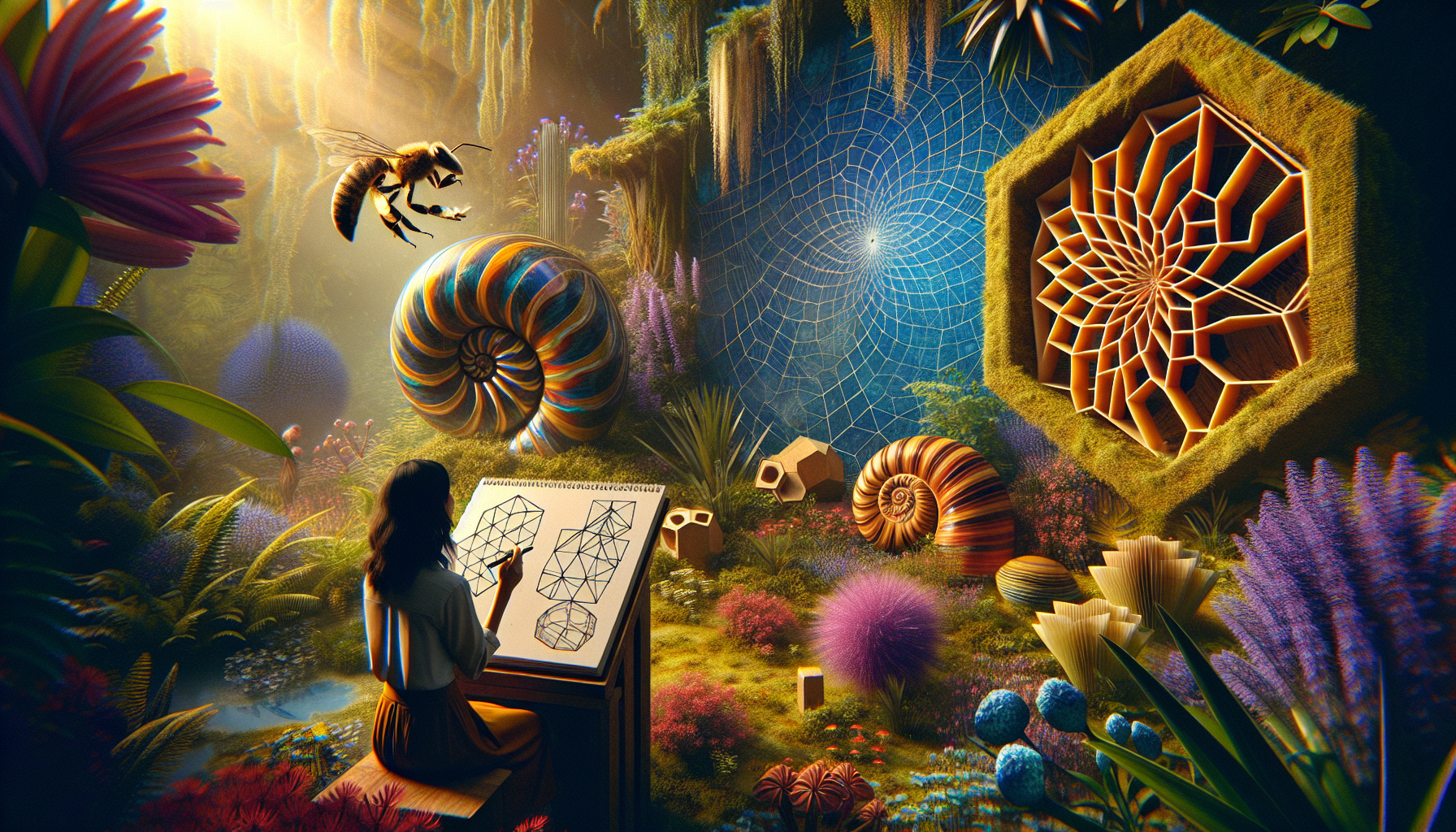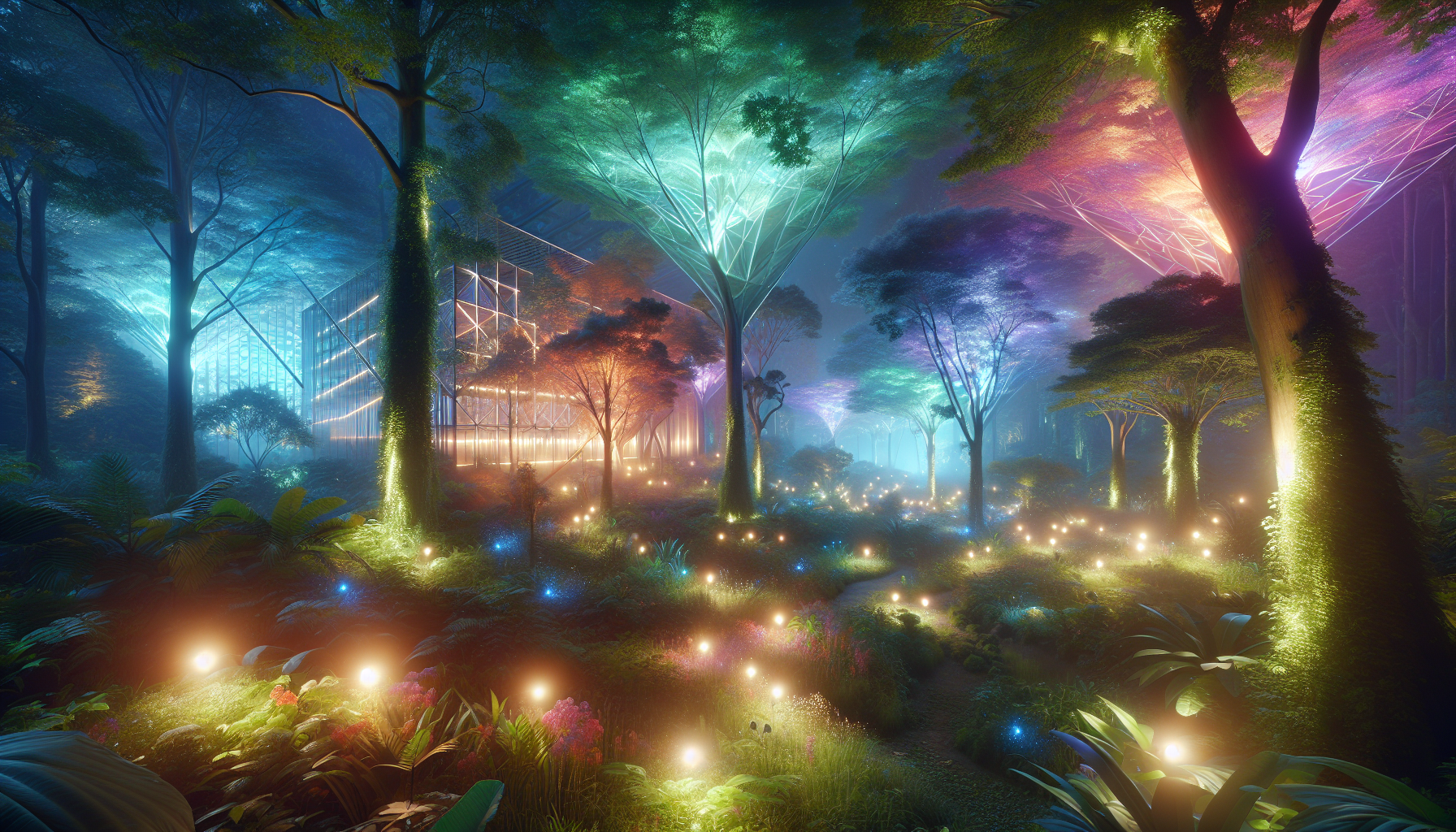In the heart of the natural world lies a breathtaking symphony of shapes and patterns that have inspired human innovation for centuries. From the spiraling shells of mollusks to the mesmerizing tessellations of honeycombs, nature’s geometric designs are not just aesthetically pleasing—they are blueprints of efficiency and functionality. In our quest to solve complex human problems, designers and engineers increasingly turn to these organic patterns, discovering that the secrets to innovation are often hidden in plain sight, nestled within the flora and fauna that surround us. This article, “Nature’s Blueprint: How Geometry of the Wild Inspires Innovative Design,” delves into the fascinating intersection of nature and technology, where ancient forms are reimagined through the lens of modern design.
At the core of this exploration is the concept of biomimicry—an innovative approach where natural forms and processes are emulated to address human challenges. Imagine a world where the aerodynamic shape of a bird’s wing informs the design of aircraft, reducing fuel consumption and improving efficiency, or where the resilient structure of a spider’s silk leads to breakthroughs in creating stronger, more durable materials. These are not distant dreams; they are realities being crafted today as architects, engineers, and scientists draw inspiration from the complex geometries found in nature. Through biomimicry, we are not just borrowing nature’s forms, but also its wisdom, leading to sustainable and revolutionary advancements.
In this article, we will embark on a journey through some of the most remarkable examples of nature-inspired design. We will explore how the Fibonacci sequence, a mathematical pattern frequently found in nature, informs architectural structures and art, creating spaces that are not only visually stunning but also acoustically and energetically balanced. We’ll delve into the world of fractals—those endlessly repeating patterns that occur at every scale—and their influence on modern technology and design. From the microscopic to the monumental, fractals demonstrate how complexity can emerge from simplicity, offering a blueprint for tackling intricate design challenges.
Furthermore, we will examine the role of symmetry and proportion in nature, and how these principles are applied in fields ranging from robotics to urban planning. The symmetry of a butterfly’s wings, the proportional beauty of the golden ratio in a nautilus shell—these natural phenomena provide insights into creating harmony and balance in design. As we unravel these connections, you will discover how embracing nature’s geometric wonders can lead to innovative solutions that are both elegant and functional. Join us on this captivating exploration, where the wild becomes a wellspring of creativity and ingenuity, shaping the future of design in ways that are as profound as they are beautiful. 🌿
The Intricate Dance Between Nature and Geometry
Nature has long been a muse for human creativity, guiding the development of art, architecture, and technology. At the core of this inspiration is the geometry found in the wild—a complex, elegant dance of shapes and patterns that form the foundation of our natural world. These geometrical patterns, ranging from the spiral shells of mollusks to the hexagonal structures of honeycombs, offer us a blueprint for innovation, helping to design efficient, sustainable, and aesthetically pleasing solutions in modern engineering and architecture.
One of the most striking examples of natural geometry is the Fibonacci sequence, a mathematical pattern that appears frequently in nature. This sequence is defined as a series of numbers where each number is the sum of the two preceding ones, starting from 0 and 1. The resulting ratio, known as the golden ratio, appears in the arrangement of leaves around a stem, the branching of trees, and the spiral patterns of shells and galaxies. By understanding and applying the Fibonacci sequence, designers and architects can create structures that are not only functional but also visually harmonious and efficient.
In architecture, biomimicry has become a popular approach for integrating natural geometries into human-made structures. This practice involves emulating nature’s time-tested patterns and strategies to address human challenges. For instance, the Eastgate Centre in Harare, Zimbabwe, designed by architect Mick Pearce, uses principles inspired by termite mounds to regulate temperature naturally, reducing energy consumption and creating a comfortable environment without relying on conventional air conditioning systems. This example demonstrates how the geometry of the wild can inspire innovative design solutions that promote sustainability.
The Golden Ratio: A Universal Pattern
The golden ratio, often denoted by the Greek letter phi (Φ), is a proportion that has fascinated mathematicians, artists, and architects for centuries. Approximately equal to 1.618, this ratio is considered aesthetically pleasing and is found in numerous aspects of art and architecture, from the Parthenon in Greece to Leonardo da Vinci’s “Vitruvian Man.” In nature, the golden ratio manifests in the spirals of shells, the arrangement of sunflower seeds, and the branching patterns of trees.
One of the most famous natural occurrences of the golden ratio is in the nautilus shell, which forms a logarithmic spiral. This spiral grows outward, maintaining a constant angle and proportion, which provides the nautilus with structural integrity and efficiency. Designers and engineers often use the golden ratio to create products that are not only functional but also visually appealing, from consumer electronics to city planning.
The prevalence of the golden ratio in nature suggests that it offers a structural advantage, which humans have harnessed in various fields. For example, in product design, companies like Apple have utilized the golden ratio to craft devices that are not only high-performing but also elegant and user-friendly. The understanding and application of this ratio provide designers with a tool to create harmony and balance in their work, resulting in designs that resonate with our innate sense of beauty.
The Hexagonal Strength of Honeycombs
Honeycombs, crafted by bees with impeccable precision, are a testament to the efficiency and strength of hexagonal geometry. This pattern is not only the most space-efficient way to fill a plane with equal-sized units but also offers incredible strength, a combination that has inspired countless engineering feats. The hexagonal structure of honeycombs provides the perfect balance between strength and material efficiency, serving as a model for sustainable and resilient design.
In engineering, hexagonal patterns are used in a variety of applications, from carbon nanotubes to the design of crash-resistant car structures. The hexagonal geometry allows for even distribution of force and stress, making it an ideal shape for applications that require durability and stability. The natural elegance and efficiency of the hexagonal pattern make it a popular choice in materials science and architectural design.
Architects and engineers have applied the principles of honeycomb geometry in numerous ways. For example, the Beijing National Aquatics Center, also known as the Water Cube, uses a bubble-like structure based on the geometry of natural soap bubbles and honeycombs. This design not only reduces material usage but also creates an aesthetically striking and structurally sound building. By mimicking the geometry found in nature, designers can create innovative and sustainable solutions that enhance both form and function.
| Natural Geometry | Human Application |
|---|---|
| Fibonacci Sequence | Architectural Design, Art |
| Golden Ratio | Product Design, Visual Arts |
| Hexagonal Honeycomb | Material Science, Structural Engineering |
Discover more about these fascinating patterns by watching this insightful video: “Nature by Numbers” by Cristóbal Vila on the “Etérea Studios” channel. 🎥
Fractals: Infinite Complexity in Nature
Fractals are intricate patterns that repeat at different scales, and they are ubiquitous in nature. From the branching of trees and river networks to the formation of snowflakes and coastlines, fractals demonstrate the complexity and beauty of natural systems. The self-similar nature of fractals makes them an excellent model for understanding chaotic and dynamic processes in both nature and design.
In the realm of technology and design, fractals have found applications in various fields. Antenna design, for instance, utilizes fractal patterns to create devices that are both compact and capable of receiving a wide range of frequencies. This technology is particularly useful in the development of mobile devices, where space is limited, and efficiency is crucial.
Fractals also inspire digital art, providing artists with the ability to create intricate and captivating visuals. The infinite complexity and recursive nature of fractals make them a versatile tool for generating designs that mimic the complexity of nature. By harnessing the power of fractals, designers can explore new realms of creativity and innovation.
Fractal Applications in Modern Design
- Enhanced Antenna Design
- Digital Art and Animation
- Urban Planning and Architecture
The study of fractals offers valuable insights into the underlying patterns of nature, providing a framework for innovation and creativity in design. As we continue to explore the geometry of the wild, the possibilities for sustainable and efficient design inspired by nature’s blueprint are virtually limitless.
For a deeper dive into the mesmerizing world of fractals, check out this video: “The Mandelbrot Set – Visualizing the Complex” by Numberphile on the “Numberphile” channel.

Conclusion
In exploring the intricate relationship between nature and design, “Nature’s Blueprint: How Geometry of the Wild Inspires Innovative Design” has delved into the profound influence that the natural world has on human creativity and technological advancement. Throughout this article, we have traversed various facets of this compelling intersection, from the awe-inspiring symmetry found in the petals of a flower to the complex fractals observed in snowflakes. Each section has underscored a fundamental principle: nature’s geometry is not just a marvel to behold but a treasure trove of solutions and inspirations for innovative design.
Firstly, we discussed the pervasive presence of the Fibonacci sequence in natural formations. This mathematical sequence, evident in phenomena such as the spirals of shells and the branching of trees, provides a blueprint for efficiency and beauty in design. By mimicking these patterns, designers and architects can create structures that are not only aesthetically pleasing but also structurally sound and resource-efficient. This natural efficiency is something that modern society, with its emphasis on sustainability and resource conservation, can greatly benefit from.
Moving forward, we explored the concept of biomimicry, where nature’s time-tested patterns and strategies are emulated to solve complex human problems. Whether it’s the development of more aerodynamic vehicles inspired by the streamlined bodies of fish or the creation of fabrics that mimic the water-repellent properties of lotus leaves, biomimicry offers an eco-friendly path towards innovation. This approach underscores the importance of interdisciplinary collaboration between biologists, designers, and engineers, fostering a holistic view of problem-solving that respects and learns from the environment.
Another significant point discussed is the application of fractals in design. Fractals, with their infinite complexity and self-similar patterns, have found their way into various fields including architecture, computer graphics, and medicine. These patterns not only enhance the visual appeal but also improve functionality. For instance, urban planners are increasingly employing fractal analysis to design cities that mimic the self-organizing patterns found in ecosystems, aiming for cities that are more livable and resilient.
The article also touched upon the emotional and psychological impact of incorporating natural geometry into design. Studies have shown that environments that reflect nature’s patterns can reduce stress, enhance mood, and promote well-being. This insight is crucial for architects and interior designers aiming to create spaces that are not only functional but also therapeutic. By aligning design with the inherent harmony found in nature, we can craft spaces that nurture the human spirit.
Moreover, the discussion highlighted the role of technology in bridging the gap between nature and design. Advanced tools such as 3D printing and computer-aided design (CAD) allow designers to replicate complex natural patterns with precision. This technological synergy enables the creation of innovative products that are both sustainable and groundbreaking. As technology continues to evolve, the potential for more sophisticated and nature-inspired designs will undoubtedly expand.
In conclusion, the geometry of nature is a testament to the elegance and efficiency of the natural world. By studying and emulating these patterns, we not only gain insights into the workings of nature but also unlock new pathways for innovation in design. This symbiotic relationship between nature and technology can lead to sustainable solutions that benefit both humanity and the planet. 🌍
As we conclude this exploration, it is vital to recognize the ongoing importance of this dialogue between nature and design. The principles and examples discussed here are just the tip of the iceberg, with endless possibilities waiting to be discovered and applied. We encourage you, our readers, to delve deeper into this fascinating subject. Consider how you might integrate nature’s wisdom into your own projects or daily life. Share your thoughts, experiences, and innovations with others to foster a community of learning and inspiration.
For further reading and exploration on this topic, you might find the following resources enlightening:
– “Biomimicry: Innovation Inspired by Nature” by Janine Benyus Biomimicry Institute.
– Explore more about fractals and their applications in design at Fractal Foundation.
– Delve into the Fibonacci sequence and its role in nature and design at Math is Fun.
Let us continue to look to nature as a guide and inspiration, ensuring that the designs we create are not only innovative but also harmonious with the world around us. Feel free to comment below and share this article with others who may find inspiration in nature’s timeless designs. Together, we can build a future that respects and celebrates the magnificent blueprint of nature. 🌿
Toni Santos is a visionary artisan and conceptual designer who channels the beauty of living organisms into structural expression. At Zureste, Toni explores the intricate elegance of insect anatomy, organic flow, and bioinspired design to create art that feels both natural and otherworldly.
Each creation Toni brings to life reflects a harmonic tension between structure and softness, wildness and control — echoing the complex intelligence found in the natural world. From beetle-like silhouettes to root-shaped contours, his work blurs the lines between biology, sculpture, and modern art.
Guided by fascination for metamorphosis, evolution, and pattern in nature, Toni’s pieces embody transformation. His BioLight Collection and conceptual series like Insect Type and Structure Aesthetics offer viewers more than aesthetic value — they present immersive experiences of living design.
As the creative force behind Zureste, Toni invites us to rethink beauty, architecture, and identity through a new lens — one shaped by wings, bones, spirals, and the microscopic poetry of the organic.
🌿 His creations reflect:
-
Design deeply rooted in the geometry of life
-
Inspiration from insects, roots, and the unseen natural order
-
A blend of science, spirituality, and visual storytelling
Whether you’re a lover of strange beauty, an admirer of evolution’s artistry, or a creative mind seeking something different, Toni welcomes you into a world where living forms become meaning, and surreal becomes sublime.




